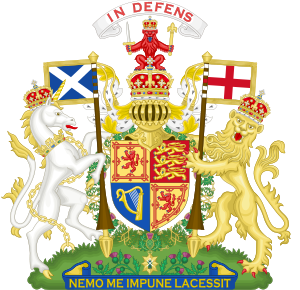Crown of Scotland

The Crown of Scotland (English: Crown of Scotland ) is part of the Scottish Crown Jewels .
Manufacturing
The crown in its present form was made for King James V of Scotland in 1540, when the velvet and ermine crown hood was added. The goldsmith John Mosman used the older, damaged crown of Jacob IV to make the new model in 1540. The older version can be seen in the portrait of Jacob IV in the book of hours produced in 1503 on the occasion of his marriage to Margaret Tudor . It is made of Scottish gold, has four crown stirrups, which are surmounted by an imperial orb. It is covered with 22 gemstones and 20 other gemstones and pearls from an older crown and weighs 1640 g. The coronet is surmounted by a total of four lilies and four leaves, which alternate with each other. In two-dimensional representations, 3 lilies and two leaves are visible.
use
The crown was first worn in the year it was made by James V at the coronation of his second wife, Mary of Guise, in Holyrood Abbey , Edinburgh . Subsequently she was at the coronations of Mary of Scotland and her son Jacob VI in 1543 . Used in 1567.
After the union of the Scottish and English crowns in 1603, when James VI. inherited the English throne and moved the royal court from Edinburgh to London , the crown was brought to sessions of the Scottish Parliament with the rest of the Honors of Scotland to symbolize the presence of the monarch and the royal approval of the legislation.
The crown was used for the coronations of Charles I in 1633 and Charles II in 1651. No monarch has been crowned since then.
During the Civil War , Oliver Cromwell , who had already destroyed the older English Crown Jewels, wanted to destroy the Scottish Crown Jewels as well. Therefore, they were buried in a secret location until the reestablishment of the monarchy in 1660.
After the Act of Union of 1707 , which merged the Kingdom of Scotland and the Kingdom of England into the United Kingdom of Great Britain , the Scottish royal crown became obsolete and no longer played a ceremonial role in the deliberations of the new Parliament of Great Britain. It was therefore locked away with the rest of the Honors of Scotland in Edinburgh Castle . There they remained in a box and remained missing until 1818 when a group, including Sir Walter Scott , set out to find them. They have been exhibited in the crown room since 1819, from which they are only removed on special government occasions. This first happened when they were shown to King George IV at the Palace of Holyroodhouse in 1822 , during the first visit by a reigning British monarch since 1651.
After Elizabeth II was coronated at Westminster Abbey on June 24, 1953 , the crown was carried to the Queen in procession from the Palace of Holyroodhouse to St. Giles Church, Edinburgh. There she was presented together with the other Honors of Scotland.
At the opening of the new Scottish Parliament in 1999 and the opening of the new Scottish Parliament building in 2004, the Crown was present during the opening sessions. On such occasions, the crown is carried directly in front of the monarch by the Duke of Hamilton , who has long been hereditary bearer of the Scottish crown in Parliament.
The Scottish crown appears in numerous coats of arms, symbols and logos of Scotland.


